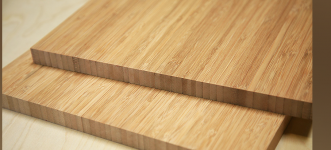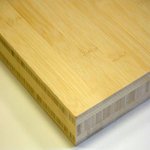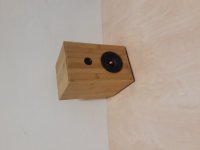So, I found what Im building my speakers from, and very much looking forward to seeing the big brown truck deliver 😀
In the bit of work I have done in my life, I know wood expands and contracts during changes in temperature and humidity. Building anything with very dissimilar properties can cause surprises down the road....
That said, I could only find one source stating the dimensional stability of bamboo wood is better than most hardwoods. Obviously, the source was a bamboo manufacturer, so naturally what they sell has to be better lol..
But, they could be stating something everyone already knows, except me lol....
Im trying to decide what to build the bracing out of. Trying to figure out what to add as interior dampening panels.
If in fact the boo is better than most hardwoods, I would imagine Huber Advantec plywood would be the most parallel, and certainly the most moisture resistant material I have ever seen...
Wondering if anyone here has any history with it...
In the bit of work I have done in my life, I know wood expands and contracts during changes in temperature and humidity. Building anything with very dissimilar properties can cause surprises down the road....
That said, I could only find one source stating the dimensional stability of bamboo wood is better than most hardwoods. Obviously, the source was a bamboo manufacturer, so naturally what they sell has to be better lol..
But, they could be stating something everyone already knows, except me lol....
Im trying to decide what to build the bracing out of. Trying to figure out what to add as interior dampening panels.
If in fact the boo is better than most hardwoods, I would imagine Huber Advantec plywood would be the most parallel, and certainly the most moisture resistant material I have ever seen...
Wondering if anyone here has any history with it...
Attachments
Wood is strongly affected by humidity, not temperature as such. Temperature coefficient is actually small, better than metalic elements, about the same as brick or tile. But temperature strongly affects relative humidity in the real world of course.
If your speakers live indoors then all you need to do is ensure the wood is properly seasoned for indoor use and it should be stable. Wooden shelving, doors, tabletops etc are a good source of properly seasoned material as they are intended for indoor decorative use and warping is not a selling point! Full seasoning costs, so bulk wood is unlikely to be such.
If your speakers live indoors then all you need to do is ensure the wood is properly seasoned for indoor use and it should be stable. Wooden shelving, doors, tabletops etc are a good source of properly seasoned material as they are intended for indoor decorative use and warping is not a selling point! Full seasoning costs, so bulk wood is unlikely to be such.
Mark, thank you. However I have seen indoor wood shrink and expand from changes in RH. Oak flooring for example, its not uncommon for the gaps between to get up to a little less of a dime in thickness. Over a dime, and the wood was to wet during install.. that said, i fear that the factory layup might split at one of the many but joints if say mdf inside expanded sooner and more.... if the entire box was made from one material, the problem would pretty much cancel it self out. In furnature making, wide slabs across grain are usually fixed in a way that allows this movement. That would be impractical for a speaker... Quite possibly Im worried about nothing and the 1' 3" width (across grain) isn't enough to consider.
These bamboo plywood are of course not natural bamboo.
They can never come in such big pieces.
The bamboo is first strip into loose fibres.
These are then soaked with resin and pressed together to forum those bamboo ply.
The fibre is much tougher than wood fibre, and the strength comes from the resin.
But it is likely to have less damping than natural wood ply.
Patrick
They can never come in such big pieces.
The bamboo is first strip into loose fibres.
These are then soaked with resin and pressed together to forum those bamboo ply.
The fibre is much tougher than wood fibre, and the strength comes from the resin.
But it is likely to have less damping than natural wood ply.
Patrick
Flooring timber I would expect to be prone to some warping, its bulk wood, probably uneconomic to fully season, and expected to be screwed down tight. I've not noticed quality wooden furniture having warpage problems, especially stuff made for modern centrally-heated homes (as opposed to antique). I don't know about bamboo, other than its very tough and very rot-proof, and used for scaffolding among other things, suspect excellent mechanical properties.
I don’t know about these solid bamboo boards, i do know that Kurt @ qualifi in Denmark suses similar. As EVUL points out this is a laminate of vertical bamboo slices.
I would consider using this if i did not feel that proper bamboo plywood is available, and the stranded variety is by far the best. Next is teh vertical (which has outer plies put together the same way as these bamboo boars.
PlybooStrand Bamboo Plywood and Veneer | Plyboo
It is worth noting that bamboo is not wood, but a grass.
This document has more info on how it is made: https://www.plyboo.com/sites/all/files/downloads/working_with_plyboostrand 20121008.pdf
dave
I would consider using this if i did not feel that proper bamboo plywood is available, and the stranded variety is by far the best. Next is teh vertical (which has outer plies put together the same way as these bamboo boars.
PlybooStrand Bamboo Plywood and Veneer | Plyboo
It is worth noting that bamboo is not wood, but a grass.
This document has more info on how it is made: https://www.plyboo.com/sites/all/files/downloads/working_with_plyboostrand 20121008.pdf
dave
I'd be wary of using panels made using a single side lamination process as shown in OP. This is not strand/resin impregnation but strip lamination, see here. I'd be more comfortable with a traditional 3 or 5 ply construction as shown.
Also, why would you want to use a different material for the bracing?
I'll leave you with a left-field suggestion for lining that bamboo enclosure;
Ubbink - Ubbink UK | Home
Also, why would you want to use a different material for the bracing?
I'll leave you with a left-field suggestion for lining that bamboo enclosure;
Ubbink - Ubbink UK | Home
Attachments
... 3 or 5 ply construction...
I have seen a richness in choice of bamboo plywood in Oz than i have not seen here. All 3 ply, 18 or 12mm thick. You could make an incredible plywood using 5 or 7 of the outer stranded veneer and either a 10-ton press or a vacuum bag.
I wonder how easily the veneer is deformed?
dave
I don’t know about these solid bamboo boards, i do know that Kurt @ qualifi in Denmark suses similar. As EVUL points out this is a laminate of vertical bamboo slices.
I would consider using this if i did not feel that proper bamboo plywood is available, and the stranded variety is by far the best. Next is teh vertical (which has outer plies put together the same way as these bamboo boars.
PlybooStrand Bamboo Plywood and Veneer | Plyboo
It is worth noting that bamboo is not wood, but a grass.
This document has more info on how it is made: https://www.plyboo.com/sites/all/files/downloads/working_with_plyboostrand 20121008.pdf
dave
Can you figure out how to ply 3 ply bamboo sheet good from that site?
All I can see is flooring and architectural panels...
Thank you,
David.
I have seen a richness in choice of bamboo plywood in Oz than i have not seen here. All 3 ply, 18 or 12mm thick. You could make an incredible plywood using 5 or 7 of the outer stranded veneer and either a 10-ton press or a vacuum bag.
I wonder how easily the veneer is deformed?
dave
Hi Dave,
That richess of choice you mentioned sadly has become a thing of the past. Ye old economy, rapidly changing trends and a distinct shift of buyer values (enviro-friendly etc). These were dinosaurs of manufacturing, but they were artisans. I can remember architects and specifiers being aghast at just the sight of these facilities.
Veneer is fantastic. To think it can be peeled, sliced, spliced, glue/stitched, grain-matched, inlaid, coloured, re-glued and re-cut and formed. It was magical watching intricate jobs come together. As you say veneer can be roll formed along it's grain and also across it's grain with a suitable membrane press. It lends itself readilly to correction/rectification whether it be fabricator error, sudden client-inspiration or other misadventure.
The only other material that gripped my imagination so was Corian funnily enough. Anyway thats another story...
I don't remember ever seeing 100% bamboo used in this fashion(core and face, multi-ply) but I see no reason why it couldn't be done.
Dennis
As a highly scientific test, I took two bamboo board cut offs, that measured almost exactly the same.
1 was 1.080 and the other 1.082...
Put one in a cup of water, nearly 24 hours later it measures 1.090 So, it grew 8 thou when soaking wet. Dont imagine it could get much wetter.
In comparison the second block was placed on a warm surface (Laptop power supply) for almost 24 hours and it now measures 1.076 or a reduction of 4 thou...
Even if I take the difference, of the two, add them its .012
Since the samples were almost 1" to begin, and my widest panel is 15" I multiply the .012 by 15 and I get a whopping .180 or a hair under 3/16"
Since I don't plan on submerging these anytime soon, Id say that's pretty dang stable.
All in all, I still need to make some allowances, but clearly a heavy 16th to an eight of space per edge should do it...
1 was 1.080 and the other 1.082...
Put one in a cup of water, nearly 24 hours later it measures 1.090 So, it grew 8 thou when soaking wet. Dont imagine it could get much wetter.
In comparison the second block was placed on a warm surface (Laptop power supply) for almost 24 hours and it now measures 1.076 or a reduction of 4 thou...
Even if I take the difference, of the two, add them its .012
Since the samples were almost 1" to begin, and my widest panel is 15" I multiply the .012 by 15 and I get a whopping .180 or a hair under 3/16"
Since I don't plan on submerging these anytime soon, Id say that's pretty dang stable.
All in all, I still need to make some allowances, but clearly a heavy 16th to an eight of space per edge should do it...
- Home
- Design & Build
- Construction Tips
- Dimensional stability Bamboo Wood (Solid)


